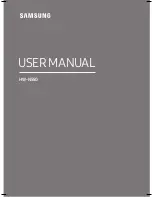
Installation and Programming Manual
Mircom Technologies Inc
All Rights Reserved
LT-1034 Rev.1
Page 16 of 54
The
ISDs must be enrolled onto the network (see Section 5.13)
When an ISD is enrolled onto the network, the
NMC assigns a ‘Network ID’ to each individual ISD. If an ISD is to be permanently removed,
it must be removed
from the NMC database or a trouble condition on the NMC will occur, constantly reporting the missing
ISD unit.
(
See Section 5.14
– “Removing an ISD”).
Each ISD is identified on the network by its
Address #
and
VID #
. These 8 characters
VID
numbers are factory
assigned to the individual protocol chips and cannot be changed. These numbers must be enrolled onto the NMC
network in order for the NMC to communicate with each of the ISDs. If these numbers are not entered into the
NMC or entered incorrectly, the NMC will not be able to identify or locate the ISD.
The 5, or less, character alpha-numeric
Address
#
is the friendly name of the ISD and is field programmable. It
generally indicates the suite number or location of the ISD. The
Address #
can be edited if required.
The
VIDs
and
Addresses
should be entered into the NMC
prior
to site installation. This will help speed up the
installation process.
VIDs
and
Addresses
can be entered directly from the keypad via the “
Manual Set Address
”
menu or “
Auto Set Address
” menu for very small quantities, or manually via the Windows
®
based
FIRE-
LINKLOAD
download program using the barcode scanner (Dealer purchased), for large quantity installs.
The Routing Process – A Stable Network:
FIRE-LINK’s
‘MESH NETWORK’
is maintained by a unique routing process. As the power line can be a very
harsh and noisy communications medium, one that is being constantly changed by the addition or movement of
other electrical equipment, the NMC communications polling routine will establish new ‘routes’ if required to
maintain the network integrity. That is, if the NMC cannot establish or maintain communications with an ISD unit,
it will try and re-establish the link using other ISDs as repeaters. This will occur before and after recording the ISD
unit(s) as missing on the NMC display. This routing is an ongoing, ‘behind the scenes’ process that ensures a
stable communications network.
2.8 Panel Operation
The NMC Panel has two sets of keys (Function Keys and Alpha/Numeric Keys), four Status LEDs and a four line
LCD display. The Function Keys are described as follows:
RESET:
Resets the NMC after an alarm condition. This will put the NMC into the NORMAL state after all alarms are
cleared. If using the Bell Output Relay, the reset of an alarm condition will be automatic from the FACP reset.
ACK:
Acknowledges an alarm or trouble condition. When pressed to acknowledge a trouble condition, this will silence
the NMC piezo. The yellow Trouble LED will continue to be on until the trouble is cleared. When pressed to
acknowledge an alarm condition, this will silence the NMC piezo. The red Alarm LED will continue to be on and
the ISDs will continue to sound.
ALARM SILENCE:
The alarm silences the ISDs during an alarm condition. Pressing ALARM SILENCE will place a trouble on the
NMC until reset is pressed.
MENU:
This key accesses all of the menu forms for setting up the NMC parameters, enrolling the ISDs and viewing the
event logs. When in the Menu forms, the Function Keys become menu navigation keys. The menu functions are
displayed on the LCD display just above the Function Keys.
Alpha/Numeric Keys:
These keys are used to enter data into the menu fields. See Programming section.
Содержание Fire-Link ISD-1000 Series
Страница 2: ......
















































